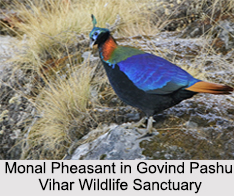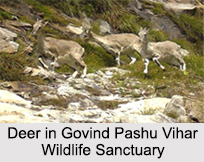 Govind Pashu Vihar Wildlife Sanctuary is a wildlife sanctuary in Uttarkashi of Uttarakhand. It was established in the year 1955, March 1. This sanctuary covers an area of about 958 square kilometers. In Govind Pashu Vihar Wildlife Sanctuary, Indian government initiated the Snow Leopard Project to conserve the snow leopards. The park lies in the higher reaches of the Garhwal Himalayas. Also, it is one of the remaining spots in the Himalayas of the bearded vulture, a vital ecological catalyst.
Govind Pashu Vihar Wildlife Sanctuary is a wildlife sanctuary in Uttarkashi of Uttarakhand. It was established in the year 1955, March 1. This sanctuary covers an area of about 958 square kilometers. In Govind Pashu Vihar Wildlife Sanctuary, Indian government initiated the Snow Leopard Project to conserve the snow leopards. The park lies in the higher reaches of the Garhwal Himalayas. Also, it is one of the remaining spots in the Himalayas of the bearded vulture, a vital ecological catalyst.
Flora in Govind Pashu Vihar Wildlife Sanctuary
The sanctuary houses western Himalayan broadleaf forests at its lowest elevations and western Himalayan subalpine conifer forests and western Himalayan alpine shrub and meadows at its highest elevations. Trees of the lower parts of the sanctuary include chir pine, deodar cedar, oak and other deciduous species. At altitudes over about 2,600 meters, there are common species including conifers such as blue pine, silver fir, spruce, yew and deciduous species such as maple, walnut, horse chestnut, hazel and rhododendron.
 Fauna in Govind Pashu Vihar Wildlife Sanctuary
Fauna in Govind Pashu Vihar Wildlife Sanctuary
The sanctuary is the abode of about 15 species of large mammals and almost 150 species of birds. The snow leopard project of this sanctuary aims to provide special conservation measures to protect the snow leopards- this is one of the most endangered animals for being poached for its skin and body parts and being killed by farmers. They kill them to protect their livestock. Other mammals, which are found in this sanctuary park, are Asian black bear, brown bear, common leopard, musk deer, bharal, Himalayan tahr and serow. Smaller mammals are Indian crested porcupine, European otter, goral, civet, hedgehog, Himalayan field rat, Hodgson`s giant flying squirrel, wild boar, masked palm civet and Sikkim mountain vole. Birds of this sanctuary include several endangered species such as the golden eagle, steppe eagle and the black eagle, bearded vulture, Himalayan snowcock, Himalayan monal pheasant, cheer pheasant and western tragopan. Smaller birds include owls, pigeons, minivets, thrushes, warblers, bulbuls, parakeets, cuckoos, tits, buntings, finches etc.
Tourism in Govind Pashu Vihar Wildlife Sanctuary
There is Har-ki-dun valley inside the sanctuary, which is a popular spot for trekking. Ruinsiyara high altitude lake is also a popular place among tourists. The Har-ki-dun Forest Rest House is a famous place for its location amidst a valley of wild flowers. The forest rest houses of Naitwar, Taluka and Osla are en route to Hari-ki-dun, which attract large number of tourists. Tourists from all over the world visit this place for trekking or visiting the sanctuary.
Visiting Information to Govind Pashu Vihar Wildlife Sanctuary
The best time to visit this place is from May to October. The nearest airport and railway station to this place are in Dehradun at a distance of 190 km. Dharkadhi is the nearest town to this sanctuary, which is located at a distance of 17 km from the sanctuary.



















